Though their value may not be immediately apparent, US coins can be interesting and fun to collect. Each coin tells a unique story about American history, and many collectors take pride in owning a complete set. One interesting coin is a Kennedy half dollar. If you have a 1776 to 1976 half dollar, it is likely worth more than face value.
A 1776 to 1976 half dollar is a commemorative coin that was minted to celebrate the United States bicentennial. These coins are made of copper-nickel and were only produced for a limited time. Because they are no longer in production, they are quite valuable to collectors. In this blog post, we will discuss the value of these coins and how to sell them. Keep reading!
What is a 1776-1976 Bicentennial Kennedy Half Dollar?
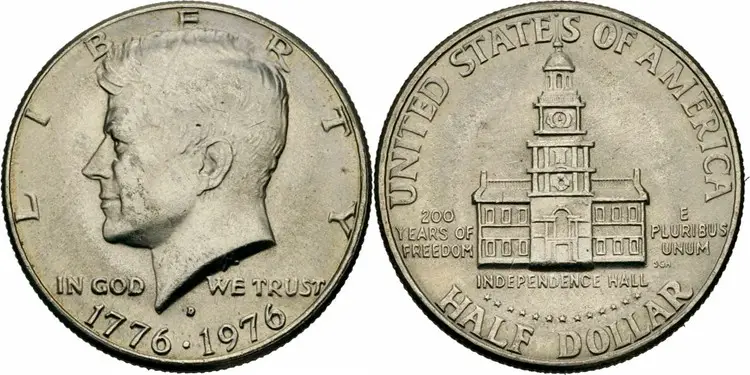
The 1776-1976 Bicentennial Kennedy Half Dollar was a commemorative coin minted to celebrate the 200th anniversary of the United States Declaration of Independence. The coins were struck in both silver and copper-nickel clad composition. Unlike most other U.S. coins, the Bicentennial Kennedy Half Dollar was only minted for one year and is now a prized collectors item.
The word “bicentennial” is derived from the Latin word “bis”, meaning “two”, and the Greek word “ennéa”, meaning “hundred”. Together, these words give us the term “two hundred years”. The bicentennial is a special anniversary that is celebrated every 200 years. It is a time to reflect on the past, celebrate the present, and look to the future.
This coin features John F. Kennedy, the 35th president of the United States. He was a member of the Democratic Party and took office in 1961. Sadly, his Presidency was cut short when he was assassinated in 1963. However, Kennedy’s legacy lives on, and he is considered one of the most successful Presidents in American history.
The United States celebrated its bicentennial in 1976, two centuries after the signing of the Declaration of Independence. For countries, the bicentennial is an opportunity to showcase their history and culture.
What Does a 1776 to 1976 Bicentennial Half Dollar Look Like?
The coin was designed by John R. Sinnock and its reverse side features an image of Independence Hall in Philadelphia along with the motto “200 YEARS OF FREEDOM”. The obverse side of the coin features the same design as other Kennedy half dollars – a portrait of John F. Kennedy.
Some coins are minted with no mint mark. If there is a mint mark preset, it can be found on the obverse of the coin above the date.
This coin is a great example of American craftsmanship and pride. Every detail on the coin is meticulously done, and it shows how much care and attention went into its creation.
The Most Common Kennedy Half Dollars
The US minted several different half dollars in 1776-1976 to commemorate the country’s bicentennial. The most common version is the 1776-1976 half dollar with no mint mark, which was minted for general circulation. There are also 1776-1976 D half dollars, which were minted at the Denver mint, and 1776-1976 S proof and silver half dollars, which were minted at the San Francisco mint.
Series |
Mint location |
Number of minted coins |
1776-1976 |
Philadelphia |
234,308,000 |
1776-1976 D |
Denver |
287,565,248 |
1776-1976 S Proof |
San Francisco |
7,059,099 |
1776-1976 S Silver |
San Francisco |
11,000,000 |
1776-1976 S Silver Proof |
San Francisco |
4,000,000 |
The silver-proof half dollars were only available through special sets issued by the US Mint. All of these coins are now collectibles and can be worth more than their face value.
Are Silver Kennedy Half Dollars Hard to Find?
Many people enjoy the challenge of finding all the different varieties, and the silver Kennedy half dollar is one of the most coveted. Unfortunately, these coins are also quite rare. Less than 20 million coins were released into circulation. As a result, they can be quite difficult to track down, especially in high grades.
How Can You Tell if a Bicentennial Half Dollar Is Silver?
Some of these coins are made of silver, while others are made of a copper-nickel alloy. So, how can you tell if a Bicentennial Half Dollar is silver?
The best way to determine the composition of a coin is to contact a professional numismatist. If you want to do it yourself, you can try by looking at the coin itself. The plating will be seen on the newer-designed coins, but the earlier silver coins will appear to be silver when held up to the light.
Are There any Errors on Bicentennial Half Dollars?
Every coin collector knows that a coin with an error will be worth more than the one without it. The most common error is the double die coin. A double die error is a type of minting error that occurs when the die strikes the coin twice, resulting in a doubled or even a tripled image. This can happen with any element of the design. Double die errors are relatively rare, and they are highly prized by collectors.
When it comes to Bicentennial half dollars, the most common die error is when the coin’s words appear to be tripled. The doubling has the largest impact on the word TRUST on the obverse.
When a coin is minted, it goes through several steps to ensure its quality. One of these steps is to ensure that the image on the coin is centered. However, sometimes a mistake can be made and the image ends up off center. While this may seem like a small error, it can have a big impact on the value of the coin. Off.center coins are much rarer than those that are perfectly centered, and as a result, they are often highly sought after by collectors. In some cases, an off-center coin can be worth several times more than a normal coin.
Grading System for 1776 to 1976 Half Dollar Coins
The Sheldon Scale is a numerical rating system for the condition of coins. The scale ranges from 0 to 70, with 70 being the highest possible score and 0 being the lowest. Coins are graded on a variety of factors, including wear, luster, strike, and surface defects.
Most collectors strive to acquire coins that fall into the 60-70 range, as these coins are usually in good condition and retain most of their original luster. Coins in the 50-60 range may have some light scratching or wear, but they are still attractive and desirable.
Coins in the 40-50 range are beginning to show significant wear, and those in the 30-40 range are heavily worn. Coins that fall below 30 on the Sheldon Scale are generally not collected, as they offer little value beyond their intrinsic metal content.
However, some collectors do choose to collect “junk silver” coins, which are typically low-grade examples of common denominations such as dimes, quarters, and half dollars. Whatever your collecting goals may be, it is important to be familiar with the Sheldon scale in order to make informed decisions about the coins you purchase.
The system was developed by Dr. William H. Sheldon in 1949 and has been widely adopted by coin collectors and dealers as a way to standardize coin grading. While the Sheldon scale is not perfect, it provides a helpful guide for collectors and dealers when assessing the value of a coin.
How Much is a 1776 to 1976 Half Dollar Worth?
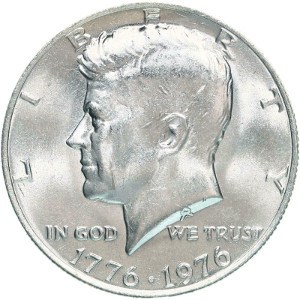
The standard 1776 to 1976 half dollar value in the circulated condition is worth only their face value. In uncirculated condition with an MS 63 grade and no mint mark, they are worth around $3.
Over 234,308,000 half dollars were minted, so they’re not considered rare. Because of their low value, they are often sold in bulk. For example:
- 20 Kennedy half dollar coins sold for $15 on eBay recently.
- A lot of 7 Kennedy half dollar coins in a slightly better condition sold for the same price.
- A lot of 15 coins in a slightly worse condition sold for half that price in the same period.
While most regular Kennedy half dollars are worth only $0,50, if y0u have some that are in particularly good condition they can sell for several times their face value.
How Much is a 1776 to 1976 D Half Dollar Worth?
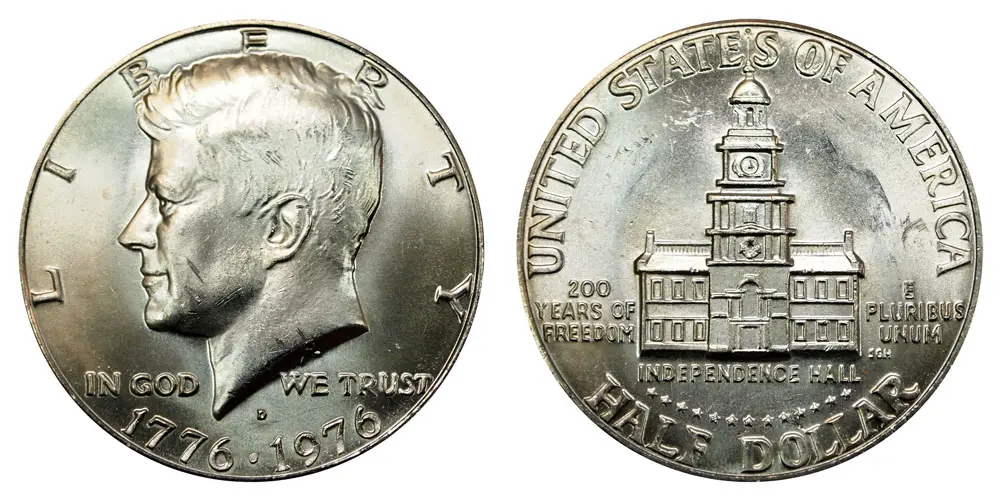
1776 to 1976 D Half Dollar
Circulated examples of the 1776-1976 D Kennedy half dollar coins are worth between 50 cents and 75 cents, while uncirculated examples can bring $1 to $4. Let’s take a look at some of the recently sold examples:
- A lot of two bicentennial dollars sold for $4, so each one is worth about $2.
- A 1776-1976 Kennedy half dollar sold for only $1.
- Uncirculated Kennedy half dollar sold for $4 in the same period.
However, if the coin is graded by a professional service such as Numismatic Guaranty Company or Professional Coin Grading Service, 1976 D Kennedy Half Dollar Value can be worth $20 in MS65 and $40 in MS66. As a result, collectors should be sure to have their Bicentennial Kennedy half dollars professionally graded in order to maximize their value.
How Much are 1776 to 1976 Silver Half Dollars Worth?
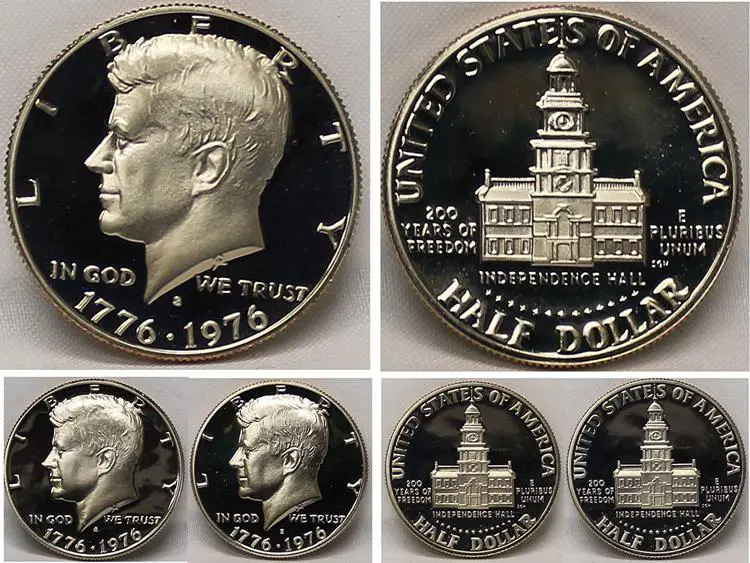
1776 to 1976 Silver Half Dollars
The 1976 Bicentennial Silver Uncirculated Half Dollar is a relatively rare and valuable coin. While its base value is simply the silver melt value – currently $3.24 – collectors are willing to pay significantly more for an uncirculated coin in good condition. You can check the silver melt value on this website.
The 1776-1976 silver half dollar coin is worth a minimum of $8 in uncirculated condition. The 1776-1976 silver-proof coins, however, are worth more because they were originally produced before the actual issue of a coin.
Let’s take a look at some of the recently sold silver Kennedy half dollars:
- Aspecial 1976 S bicentennial three-coin set with a mirror-like proof finish sold for $23.50.
- Single silver Kennedy half dollar sold for around $14.
- A similar coin sold for around $10.
- A nearly perfect example of 1976 S Kennedy half dollar sold for $20 on Heritage Auctions.
As you can see, the 1776-1976 silver half dollar coin is a popular choice among collectors because of its history and cultural significance. If you have one of these coins, you have a piece of history that is sure to be valuable for many years to come.
How Much is a 1776 to 1976 Off-Center Half Dollar Worth?
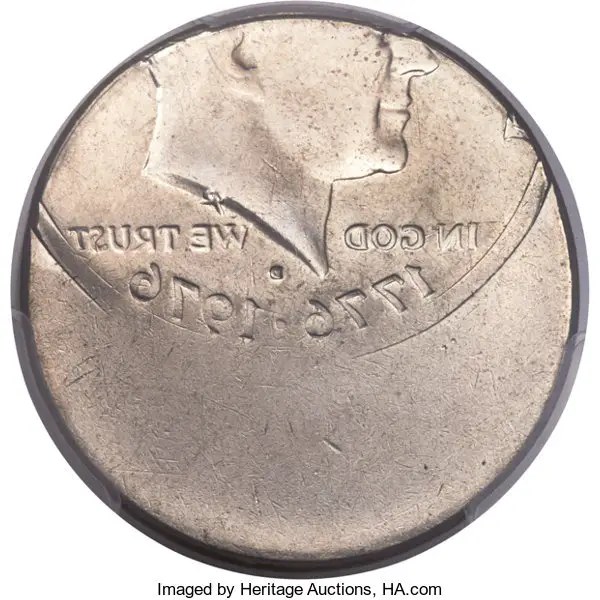
1776 to 1976 Off-Center Half Dollar
1776 to 1976 Off-Center Half Dollar coins are among the most valuable coins. This is due to the error that was made when they were minted. Off-center coins are those where the stamped image is not centered on the coin. The value of a 1776 to 1976 Off-Center Half Dollar coin depends on how far off-center the stamped image is. The most valuable coins are those that have the stamped image closest to the edge of the coin.
These “off-center” coins are highly prized by collectors, and one was recently sold at auction for $2,300.00. The coin was graded MS64 by NGC and it was struck 45% off center.
This 1976-D 50C Clad Bicentennial Half Dollar is a coin that was struck 40% off center and has a reverse mirror breakage. It was sold for $2,115.00 on Heritage Auctions. The Coin Grading Service (CGS) has graded this coin as MS63. This means that the coin is in a mint state, but it has some small blemishes that are visible to the naked eye.
While 1776 to 1976 Kennedy half dollar value will continue to fluctuate, the off-center Kennedy half dollar coin is sure to remain a collector’s item for years to come.
How Much is a 1776 to 1976 Double Die Half Dollar Worth?
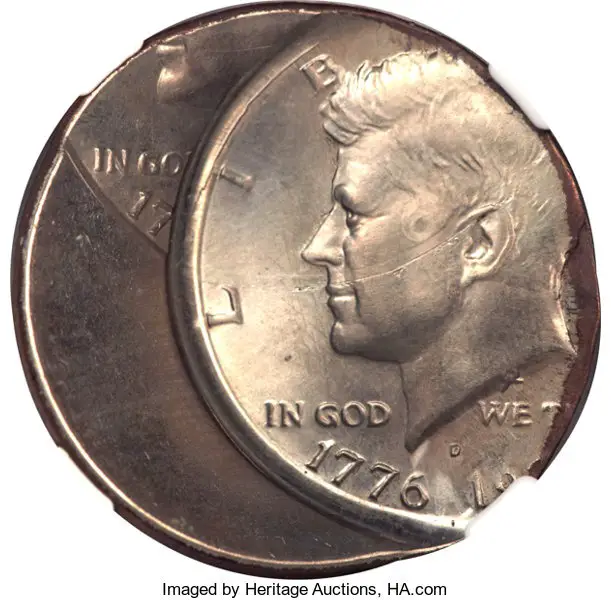
1776 to 1976 Double Die Half Dollar
The coin gets its name from the fact that some elements are imprinted twice on the face of the coin, and it is believed that this was caused by a mistake during the minting process. Due to its rarity, 1776 to 1976 Double Die Half Dollar is a valuable coin, and it has been known to sell for thousands of dollars. If you are lucky enough to find one of these coins, you may be able to cash in on a very lucrative investment.
This coin was struck twice and is off center – so it has two errors. The coin was graded as MS67, which is a condition that means the coin has no visible wear and tear, and it sold for $2,350.00. A similar coin, only graded MS64, sold for almost the same price.
These Kennedy half dollars provide a great example of how errors can occur during the minting process. Although such errors are usually considered to be flaws, they can also be viewed as unique characteristics that add to the history and value of a coin.
Where to Sell a 1776 to 1976 Kennedy Half Dollar?
If you have a 1776-1976 Kennedy half dollar, then you may be wondering where to sell it. After all, this coin is not exactly common, and it may be worth more than its face value.
Heritage Auctions is a great choice. Thanks to their vast network of collectors, they can reach a wide audience and command top dollar for even the most valuable coins. Coins with errors can fetch a high price at an auction, so if your coin falls into this category, then you could potentially earn a lot of money.
eBay is always a great option when you’re looking to sell something collectible, and that includes 1776 to 1976 Kennedy Half Dollars. These coins are highly sought after by collectors, so you’re likely to find a buyer who’s willing to pay a fair price for your coin. Other similar websites you can try include Amazon and Etsy.
Local coin stores are a great place to sell a 1776 to 1976 Kennedy Half Dollar. These businesses typically have a large selection of coins and currency, and they are always looking for new items to add to their inventory. Most importantly, local coin stores have the knowledge and experience to accurately appraise your coin. This ensures that you will receive a fair price for your item. You can use a website like Apmex to find a coin dealer near you.
You may have better luck finding a buyer by posting on online message boards dedicated to coin collecting. Here, you’ll be able to reach a wider audience of potential buyers who are specifically interested in this type of coin. Some of the most popular message boards are the Coin Talk and the Coin Community.
Whichever route you choose, be sure to do your research to get the best possible price for your coin.
Tips for Selling Kennedy Half Dollars
Kennedy half dollars are a popular choice among coin collectors, and they can be quite valuable. If you have some Kennedy half dollars that you’re looking to sell, there are a few things you should keep in mind:
- Perhaps the most important thing to remember is that condition is everything when it comes to coins. Collectors are willing to pay a premium for coins that are in pristine condition, so it’s important to grade your coins carefully before listing them for sale.
- It’s also a good idea to research the current market value of Kennedy half dollars before selling them. This will help you to get a fair price for your coins.
- Once you have an idea of their value, it’s time to find a buyer. When selling your coins, be sure to provide accurate descriptions and photos so buyers know what they are getting.
- Finally, be prepared to negotiate on price.
By keeping these tips in mind, you will be able to sell your Kennedy half dollars for a fair price.
How to Properly Store Kennedy Half Dollars
While many people enjoy collecting Kennedy half dollars, they may not know how to properly store them. Storing Kennedy half dollars correctly is important in order to preserve their value and prevent them from being damaged.
Kennedy half dollars should be stored in a cool, dry place. They should also be stored in an acid-free environment in order to prevent them from tarnishing. One way to create an acid-free environment is to store the coins in a plastic bag with a piece of baking soda. Baking soda neutralizes acids and helps to prevent tarnishing.
When storing Kennedy half dollars, it is also important to keep them separated from other coins. Coins of different metals can react with each other, damaging the coins. For these reasons, it is best to store Kennedy half dollars in individual plastic bags or coin holders.
By following these simple tips, you can ensure that your Kennedy half dollars will be properly protected and preserved.
Final Thoughts
Minted by the United States Mint in 1976 to commemorate the nation’s 200th anniversary, the Bicentennial Half Dollar is a reminder of America’s rich history and a symbol of its enduring spirit.
The value of a 1776 to 1976 half dollar depends on several factors, such as its condition, where it was minted, and whether it has a special designation (such as a “holder” or “proof” coin). Uncirculated coins are worth more than circulated coins, and coins minted at the San Francisco Mint are worth more than those minted at the Philadelphia or Denver Mints. Coins with special designations are also worth more than regular coins.
In general, most 1776 to 1976 half dollars are worth between $4 and $20. However, some rarer coins can be worth much more, especially if they have minting errors. Good luck collecting!
